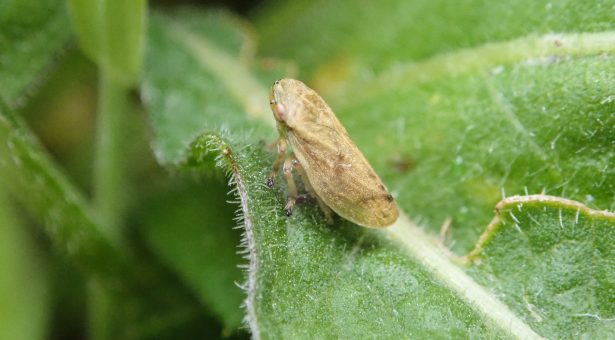UK insect vectors of Xylella

Xylella lives in the xylem of plants.
Insects that feed from the xylem can acquire Xylella and transmit the bacterium to other plants. These insects are known as vectors.
BRIGIT will investigate this relationship, the species involved and the wider movement of insects within the UK and across countries and continents.
It is estimated that there are around 20 xylem-feeding insect species that could vector Xylella in the UK (listed below).
To help map spittlebugs across the UK, we are inviting spittlebug spotters to contribute to a country-wide citizen science collaboration.
“You can help out from the comfort of your garden: if you see spittle or spittlebugs let us know where and what sort of plants you found them on,” said Dr Gerard Clover from the John Innes Centre.
Spittlebugs usually appear towards the end of April and until the end of June.
The meadow froghopper, Philaenus spumarius, has been associated with transmission of Xylella in olive in Europe. Other species are associated with transmission in the Americas, for example the leafhoppers Oncometopia fascialis and Homalodisca vitripennis are important vectors of Xylella in citrus and grapevine, respectively, and therefore other insect vectors could be important if the bacterium became established in new areas.
BRIGIT will increase our understanding of the geographical distribution and population structures of these potential vectors.
Potential Xylella vectors, their host plants and UK distribution
For more information about the insect vectors, have a look at the BRIGIT databases and resources and see the downloadable information sheets for each species.
Froghoppers/spittlebugs
- Aphrophora alni
- Host plant – Trees, esp. Alnus & Salix spp.
- UK distribution – Ubiquitous
- Aphrophora major
- Host plant – Trees, esp. Alnus & Salix spp.
- UK distribution – Widespread, not as common as A. alni
- Aphrophora pectoralis
- Host plant – Trees, esp. Alnus & Salix spp.
- UK distribution – Widespread, not as common as A. alni
- Aphrophora salicina
- Host plant – Trees, esp. Alnus & Salix spp.
- UK distribution – Widespread, not as common as A. alni
- Cercopis vulnerata
- Host plant – Herbaceous dicots
- UK distribution – Widespread England & Wales
- Neophilaenus campestris
- Host plant – Grasses
- UK distribution – Widespread, not as common as N. lineatus
- Neophilaenus exclamationis
- Host plant – Grasses
- UK distribution – Widespread, not as common as N. lineatus
- Neophilaenus lineatus
- Host plant – Grasses
- UK distribution – Ubiquitous
- Neophilaenus longiceps
- Host plant – Grasses
- UK distribution – Thames estuary
- Philaenus spumarius
- Host plant – Polyphagous
- UK distribution – Ubiquitous
Leafhoppers
- Anoterostemma ivanhofi
- Host plant – Juncus gerardii.
- UK distribution – South-east Scotland (one record)
- Cicadella lasiocarpae
- Host plant – Carex & Juncus sp.
- UK distribution – Ireland, North Wales
- Cicadella viridis
- Host plant – Juncus spp.
- UK distribution – Ubiquitous
- Euscelis incisus
- Host plant – Grasses
- UK distribution – Ubiquitous
- Euscelis lineolatus
- Host plant – Grasses
- UK distribution – Widespread, not as common as E. lineolatus
- Evacanthus acuminatus
- Host plant – Herbaceous dicots
- UK distribution – Widespread, not as common as E. interruptus
- Evacanthus interruptus
- Host plant – Herbaceous dicots
- UK distribution – Ubiquitous
- Graphocephala fennahi
- Host plant – Rhododendron ponticum
- UK distribution – South-east England, Midland
